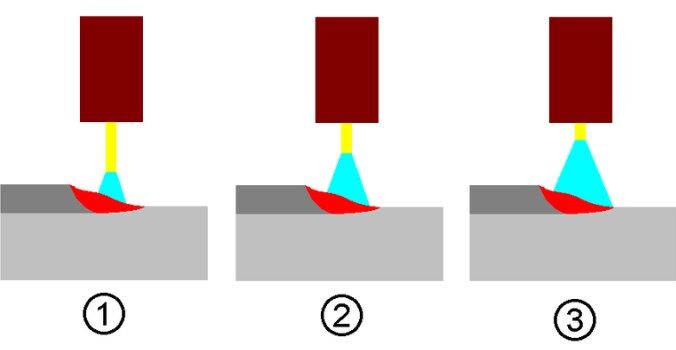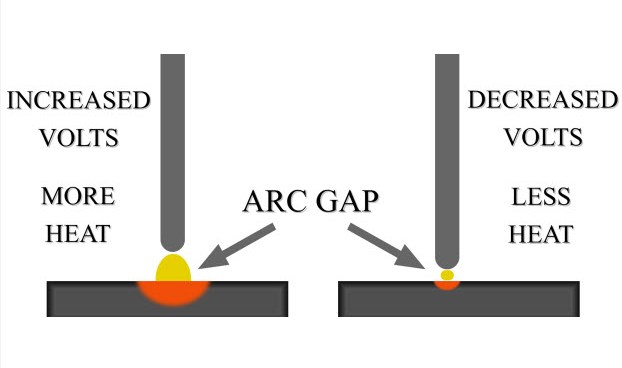Welding is a complex process that requires precision, skill, and a deep understanding of various factors that can influence the quality of the weld. One of these critical factors is arc length. The distance between the welding electrode (or welding gun) and the workpiece, known as arc length, plays a pivotal role in determining the outcome of the weld. In this article, we will explore the significance of arc length in welding and how it affects the quality and integrity of the weld.
I. The Basics of Arc Length.
Before delving into the impact of arc length on welding, let's establish a clear understanding of what arc length is. Arc length is essentially the space between the tip of the welding electrode and the surface of the workpiece being welded. This distance is dynamic and can vary during the welding process as the welder manipulates the welding torch or electrode holder.

II. The Relationship Between Arc Length and Voltage.
Arc length is intimately connected to the voltage in a welding circuit. When the arc length is increased, the electrical resistance also rises, resulting in a higher voltage. Conversely, a shorter arc length reduces the resistance, leading to a lower voltage. It's important to maintain the proper arc length to achieve a stable welding process.

III. How Arc Length Affects a Weld.
Now that we understand the basics, let's explore how arc length affects a weld:
1. Heat Input
The arc length directly influences the amount of heat transferred to the workpiece. When the arc length is too long, there is less current flow, and consequently, less heat is generated. Conversely, a shorter arc length increases current flow and heat input. Controlling the heat input is crucial because it affects the integrity of the weld.
Long Arc Length: When the arc length is too long, the weld may not fuse properly, resulting in incomplete penetration. This can lead to weak welds that are susceptible to defects such as lack of fusion and undercut.
Short Arc Length: A very short arc length can cause excessive heat input, leading to overheating of the base metal. This can result in distortion, warping, and even burn-through of thin materials.
2. Penetration
Penetration refers to how deeply the weld penetrates into the base metal. Arc length has a direct impact on penetration depth.
Long Arc Length: A longer arc length typically results in shallower penetration. This is because the heat is dispersed over a larger area, and the weld may not fully fuse with the base metal.
Short Arc Length: Conversely, a shorter arc length leads to deeper penetration. The concentrated heat generated by a shorter arc allows for better fusion between the filler material and the base metal.
3. Weld Bead Appearance
The appearance of the weld bead is an essential aspect of welding, especially in applications where aesthetics matter.
Long Arc Length: A long arc length can produce a narrow and inconsistent weld bead. It may also lead to spatter and a rough surface finish.
Short Arc Length: A shorter arc length typically results in a wider, flatter, and more uniform weld bead. This produces a neater and more visually appealing weld.
4. Welding Speed
Arc length affects the speed at which the welding process can be carried out.
Long Arc Length: With a longer arc, the welding speed tends to be slower because the heat is spread over a larger area. This can be beneficial when working on thicker materials that require a slower travel speed for proper fusion.
Short Arc Length: A shorter arc length allows for a faster welding speed, as the concentrated heat facilitates quicker fusion. This can be advantageous for welding thinner materials.
IV. How to Adjust Arc Length in Different Welding Processes?
Arc length can be adjusted by changing the distance between the electrode and the base metal or by changing the welding parameters such as voltage and current. Different welding processes have different methods of adjusting arc length, such as:
1. MIG/MAG welding: In MIG/MAG welding, arc length is mainly controlled by voltage, as voltage determines the wire feed speed and thus the electrode extension. A higher voltage results in a longer arc length, while a lower voltage results in a shorter arc length. The optimal voltage depends on factors such as wire diameter, material type, gas type, and welding position. Generally speaking, a shorter arc length is preferred for thin materials, vertical or overhead positions, and spray transfer mode, while a longer arc length is preferred for thick materials, flat or horizontal positions, and globular or short-circuit transfer mode.
2. TIG welding: In TIG welding, arc length is mainly controlled by manual manipulation of the torch or pedal, as current is proportional to arc length. A higher current results in a shorter arc length, while a lower current results in a longer arc length. The optimal current depends on factors such as electrode diameter, material type, gas type, and joint design. Generally speaking, a shorter arc length is preferred for thin materials, tight joints, and low heat input, while a longer arc length is preferred for thick materials, wide joints, and high heat input.
3. MMA welding: In MMA welding, arc length is mainly controlled by manual manipulation of the electrode holder or rod angle, as current is inversely proportional to arc length. A higher current results in a longer arc length, while a lower current results in a shorter arc length. The optimal current depends on factors such as electrode type, material type, joint design, and welding position. Generally speaking, a shorter arc length is preferred for rutile or basic electrodes (except for vertical down position), thin materials (except for vertical up position), tight joints (except for horizontal position), and low spatter; while a longer arc length is preferred for cellulose electrodes (except for vertical up position), thick materials (except for vertical down position), wide joints (except for horizontal position), and high penetration.
Conclusion
In the world of welding, arc length is a critical factor that significantly influences the quality and integrity of the weld. It affects heat input, penetration, weld bead appearance, and welding speed. Understanding how to control and optimize arc length is essential for welders to consistently produce strong, reliable, and visually appealing welds.
As technology continues to advance in the field of welding, equipment and welding processes are becoming more sophisticated, allowing for greater control over arc length and other welding parameters. Welding professionals must stay informed about these developments to stay at the forefront of the industry.
At Megmeet Welding Technology, we are committed to providing the latest welding technology and expertise to help you achieve the best possible welds. Whether you are a seasoned welder or just starting your welding journey, understanding the role of arc length is a fundamental step toward becoming a skilled and successful welder.
Related articles:
1. Bad Welding vs Good Welding: How to Tell the Difference?
2. 9 Maintenance Problems that Cause Bad Welds
3. How to Avoid Weld Cracking in High-strength Aluminium Alloys?
4. Welding Porosity: Causes, Types, Effects and Solutions
5. Welding Defects, Problems And Easy Solutions [2023]





